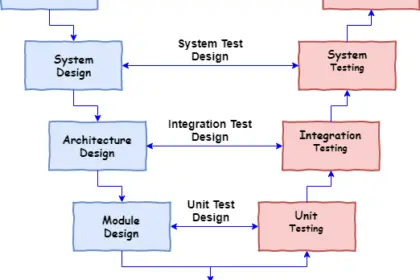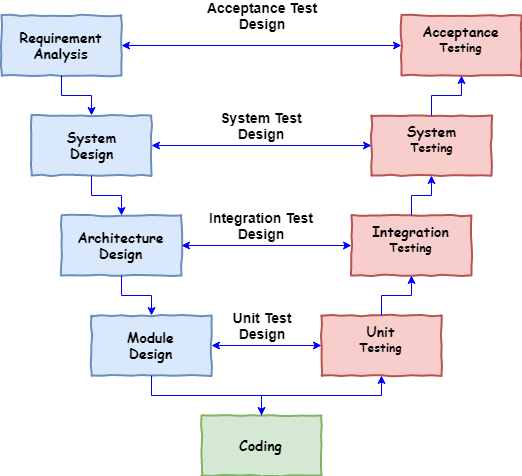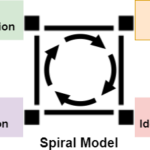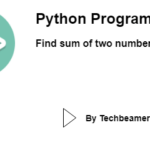Have you heard about the V model? It’s one of the most popular Software Development Life Cycle (SDLC) methodologies out there. It’s called the V model because, well, it looks like a “V” – a simple yet brilliant concept!
Understand the SDLC V Model
The V model is all about creating a linear development process that ensures quality and efficiency. It’s also known as the Verification and Validation method because it focuses on validating each phase of development.
So, what’s the big deal with the V model? It’s all about ensuring that every step of the process is thoroughly tested and validated before moving on to the next phase. This means that each development task has a corresponding testing activity, ensuring that the end product is of the highest quality.
Requirement Analysis in V Model
In other words, the V model is a streamlined approach to software development that leaves no room for error. And that’s why it’s one of the most trusted SDLC methodologies out there.
Verification
It is a static code analysis method that doesn’t require code execution. In this process, the evaluation of the product development takes place to confirm if it meets the needs of the client.
Validation
It is a dynamic analysis method and works while the code is being executed. In this process, the software goes through validation to check whether it fulfills the client’s expectations or not.
V-Model has the Verification stage on one end and the Validation phase towards the finish. Both of these techniques coincide with the programming phase in the V style. Hence, we call it the V Model.
V Model’s Design Phase
Requirement Analysis
This stage records the complete communication that happened with the client to understand his needs and expectations. This phase is known as Requirement Collection.
System Design
This stage elaborates the design of the system and captures the detailed H/W and communication infra for developing the software product.
Architectural Design
The team architects split up the System design into components having different functionality. The data exchange between the core modules and with the external world (other subsystems) get also noted down.
Module Design
In this step, the entire system splits into smaller modules. The detailed design of system components gets written down with greater clarity. We may call it the Low-Level Design (LLD) document.
V Model’s Testing Phase
Unit Testing
The developer prepares the UTP (unit test plan ) while working on the module development. They include scenarios that get executed to uncover the bugs at the programming/module level.
Integration Testing
After finishing up the unit-level validation, integration testing occurs. In this, the team integrates the components and validates the system. Integration testing happens to run in the Architecture design stage. This method confirms the communication of elements among themselves.
System Testing
System testing checks the whole system and establishes that it has the desired functionality, interdependency, and data-exchange ability. This method verifies the product from both functional and non-functional perspectives.
User Acceptance Testing (UAT)
UAT is a testing activity that occurs in a production-level environment. It ensures that the delivered product fulfills the client’s requirements and the same is ready to run in production.
Industrial Challange
Ne technologies are more complicated, faster, and forever evolving. However, each of them complies with the basic principles and standards of the IT industry.
1. Correct definition and refinement of the client requirements.
2. Architect the software as per the client’s specifications.
3. Follow a testing process that establishes that the final product adheres to the end user’s business requirements.
Principles of V-Model
Large to Small
In the V Model, the testing process runs in a hierarchical flow. The product team identifies the requirements and prepares the HLD (High-Level Design), and the Comprehensive Design stages of the product lifecycle. As these stages implement the features, the process gets more refined and descriptive.
Data and Process Integrity
This principle insists on extending the association and cohesion of both Data and Processes for producing a successful design. The identification of process components should happen for all the requirements.
Scalability
This principle emphasizes being flexible in accommodating new projects irrespective of their size, complexity, or timelines.
Cross-Referencing
Every project requirement has an associated testing activity to establish its objectives. The direct correlation between them is known as Cross-Referencing.
Tactile Documentation
This principle stresses the need for a document for the project that both the development and the support teams can access and follow the instructions for maintaining the software after it gets deployed in production.
For example – a configuration doc, quick start guide, etc.
V Model Usability
Why use it?
- Since this model’s format is static, it is easy to manage. Every stage in the V model produces the desired output followed by a review cycle.
- Testing occurs in each phase of the V model, hence more is the probability of discovering the defects.
When to use it?
- V model is likely to give better results if the requirements are available beforehand.
- It is more suitable for teams that have enough senior and experienced resources.
Pros and Cons
Advantages
- V model promotes consistency in execution and has entry and exit criteria for beginning or leaving a phase.
- It is highly successful for small projects without ambiguity in the requirements.
- This method has straightforward rules for product development.
Disadvantages
- Rigidity in the V model may lead to high risk and ambiguity.
- OO (object-oriented) and complex projects are prone to fall into issues.
- It may fail to cope with projects that have unclear and changing requirements.
Summary
Whoa there, don’t leave us just yet! We’ve got a treasure trove of amazing tutorials waiting for you on our website. From beginner-friendly tips to advanced techniques, our collection has something for everyone.
Happy Testing,
TechBeamers.










